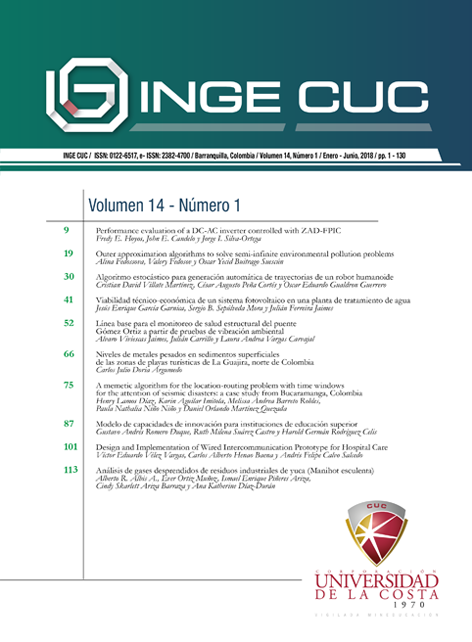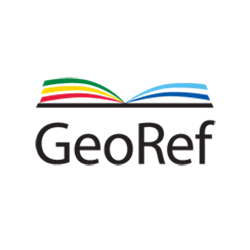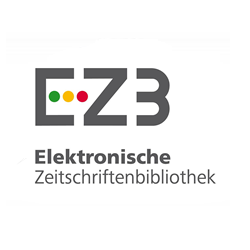Development of a methodology for the prediction of the real volume in the combustion chamber of diesel engines using finite elements
DOI:
https://doi.org/10.17981/ingecuc.14.1.2018.11Keywords:
Adjustment, Strain, Diesel engine, Simulation, Instantaneous volumeAbstract
Introduction: Currently, diagnostic thermodynamic modeling in diesel engines is a widely-used tool which is based on the pressure data inside the cylinder. However, its study requires the adjustment of submodels through iterative processes that demand excessive time and high uncertainties. Among these submodels is the instantaneous volume in the combustion chamber, since the connecting rod is a highly deformable element due to its low modulus of rigidity and, therefore, this variation affects the mechanical expansion work calculated for the global energy balance.
Objective: In this study, are trying to implement a methodology for the characterization of the instantaneous volume in the combustion chamber oriented to its estimation in a fast and precise way using the ANSYS® software.
Methodology: The characterization of a diesel engine was performed using data of pressure measured in the cylinder corresponding to tests in drag (without combustion) for the regimes of 1000, 1700 and 2400 rpm.
Results: The results obtained in the simulation and experimentally validated indicate that the proposed methodology generates homoscedasticity in the Kdef adjustment coefficient, which has a value of 0.701 for the engine under study and remains almost constant regardless of the rotation regime.
Conclusions: It is also verified that a better prediction of the real volume of the combustion chamber with the developed methodology is achieved, while the proposed adjustment factor Kdef allows the adjustment of the theoretical model proposed and absorbs the uncertainties inherent to the modeling of this type of systems.
Downloads
References
J. Heywood, Internal combustion engine fundamentals. USA: McGraw-Hill, 1998.
J. Duarte et al., “Auto-ignition control in turbocharged internal combustion engines operating with gaseous fuels”, Energy, vol. 71, pp. 137-147, jul., 2014. https://doi.org/10.1016/j.energy.2014.04.040
S. Ali y S. Saraswati, “Cycle-by-cycle estimation of cylinder pressure and indicated torque waveform using crankshaft speed fluctuations,” Trans. Inst. Meas. Control, vol. 37, no. 6, pp. 813–825, jul., 2015. https://doi.org/10.1177%2F0142331214549093
V. Macián, A. Broatch, B. Tormo y P. Olmeda, “Methodology of fault detection in internal combustion engines through the analysis of rolling block oscillation,” Int. J. Heavy Veh. Syst., vol. 16, no. 3, p. 294, 2009. https://doi.org/10.1504/IJHVS.2009.027134
J. Duarte, W. Orozco, J. González, E. Buelvas, y L. Corredor, “Thermodynamic analysis of self-ignition in spark-ignited engines operated with alternative gaseous fuels”, Tecciencia, vol. 11, no. 20, pp. 57-65, 2016. http://dx.doi.org/10.18180/tecciencia.2016.20.8
J. Duarte, J. García, J. Jiménez, M. Sanjuan, A. Bula, y J. González, “Auto-ignition control in spark-ignition engines using internal model control structure”, Journal of Energy Resources Technology, vol. 139, no. 2, jul., 2016. https://doi.org/10.1115/1.4034026
C. Rakopoulos y E. Giakoumis, “Review of thermodynamic Diesel engine simulation under transient operating conditions”, SAE Tech. Paper, no. 2006-1-884, mar., 2006. https://doi.org/10.4271/2006-01-0884
D. Assanis, Z. Filipi, S. Fiveland y M. Syrimis, “A Predictive Ignition Delay Correlation Under Steady-State and Transient Operation of a Direct Injection Diesel Engine,” J. Eng. Gas Turbines Power, vol. 125, no. 2, p. 450, abr., 2003. https://doi.org/10.1115/1.1563238
C. Barba, C. Burkhardt, K. Boulouchos y M. Bargende, “A phenomenological combustion model for heat release rate prediction in high-speed DI Diesel engines with common rail injection”, SAE Paper, no. 2001-01-2933, oct., 2000. https://doi.org/10.4271/2000-01-2933
H. Omidvarborna, A. Kumar y D. Kim, “Recent studies on soot modeling for diesel combustion,” Renew. Sustain. Energy Rev., vol. 48, pp. 635–647, ago., 2015. https://doi.org/10.1016/j.rser.2015.04.019
J. Arrègle, J. López, J. García y C. Fenollosa, “Development of a zero-dimensional Diesel combustion model. Part 1: analysis of the quasi-steady diffusion combustion phase”, Applied Thermal Engineering, vol. 23, no. 11, pp. 1301-1317, ago., 2003. https://doi.org/10.1016/S1359-4311(03)00079-6
V. Jiménez, “Contribución al modelado unidimensional de motores de dos tiempos de altas prestaciones”, Tesis doctoral, Univ. Politécnica de Valencia, Valencia, 2013.
F. Payri, P. Olmeda, J. Martín y A. García, “A complete 0D thermodynamic predictive model for direct injection Diesel engines”, Applied Energy, vol. 88, no. 12, pp. 4632-4641, dic., 2011. https://doi.org/10.1016/j.apenergy.2011.06.005
G. Amador et al., “Characteristics of auto-ignition in internal combustion engines operated with gaseous fuels of variable methane number”, Journal of Energy Resources Technology, vol. 139, no. 4, mar., 2017. https://doi.org/10.1115/1.4036044
J. Bittle, B. Knight y T. Jacobs, “Two-stage ignition as an indicator of low-temperature Diesel combustion”, Combustion Science and Technology, vol. 183, no. 9, pp. 947- 966, mayo, 2011. https://doi.org/10.1080/00102202.2011.557672
M. Lapuerta, O. Armas y V. Bermúdez, “Sensitivity of Diesel engine thermodynamic cycle calculation to measurement errors and estimated parameters”, Applied Thermal Engineering, vol. 20, no. 9, pp. 843-861, jun., 2000. https://doi.org/10.1016/S1359-4311(99)00069-1
F. Payri, S. Molina, J. Martín y O. Armas, “Influence of measurement errors and estimated parameters on combustion diagnosis”, Applied Thermal Engineering, vol. 26, no. 2-3, pp. 226-236, feb., 2006. https://doi.org/10.1016/j.applthermaleng.2005.05.006
J. Duarte, G. Amador, J. García, M. Sanjuan y L. Corredor, “Application of mechanisms for the control of autoignition in high power internal combustion engine fueled with natural gas”, presentado en ASME 2013 7th International Conference on Energy Sustainability, Minneapolis, Minnesota, USA, 2013. https://doi.org/10.1115/ES2013-18023
O. Armas, “Diagnostico experimental del proceso de combustión en motores Diésel de inyección directa”, Tesis doctoral, Univ. Politécnica de Valencia, Valencia, 1998.
W. Velilla, R. Mendoza y G. Triana, “Análisis estructural mediante simulación IAO en una estructura de carga y su validación”, INGE CUC, vol. 8, no. 1, pp. 231-240, oct. 2012.
A. Viviescas, L. Herrera y S. Arenas, “Determinación de la capacidad resistente de puentes viga-losa en concreto postensado mediante pruebas de vibración ambiental: Caso de estudio Puente El Ramo”, INGE CUC, vol. 13, no. 1, pp. 32-41, 2017. http://dx.doi.org/10.17981/ingecuc.13.1.2017.03
A. Delgado-Mejia, L. Olmos-Villalba y S. Rivero-Mejia, “Estudio comparativo del ciclo indicado de un motor diésel mediante simulación CFD y datos experimentales,” Rev. UIS Ing., vol. 13, no. 1, pp. 23–31, mar. 2014.
S. Weisberg, Applied linear regression, 3.a ed. Hoboken, New Jersey, 2005.
J. Cano, “Determinación de deformaciones mecánicas en un MCIA en condiciones de motor arrastrado”, Proyecto fin de carrera, Univ. Castilla-La Mancha, Ciudad Real, 2013.
J. Benajes, P. Olmeda, J. Martín y R. Carreño, “A new methodology for uncertainties characterization in combustion diagnosis and thermodynamic modelling”, Applied Thermal Engineering, vol. 71, no. 1, pp. 389- 399, mayo, 2014. https://doi.org/10.1016/j.applthermaleng.2014.07.010
Nissan, Nissan Almera Tino V10 Service Manual, September 2003. Nissan Europe S.A.S., 2003.
J. Shigley y J. Uicker, Teoría de máquinas y mecanismos. México D.F.: McGraw-Hill, 2001.
R. Juvinall and K. Marshek, Fundamentals of machine component design, 5.a ed. Hoboken, New Jersey: John Wiley & Sons, Inc., 2012.
J. Duarte, “Aportación al estudio y modelado termodinámico en motores de combustión interna”, Tesis doctoral, Univ. del Norte, Barranquilla, Atlántico, 2016.
J. Martín, “Aportación al diagnóstico de la combustión en motores Diésel de inyección directa”, Tesis doctoral, Univ. Politécnica de Valencia, Valencia, 2007.
F. Payri, P. Olmeda, C. Guardiola y J. Martín, “Adaptive determination of cut-off frequencies for filtering the in-cylinder pressure in Diesel engines combustion analysis”, Applied Thermal Engineering, vol. 31, no. 14- 15, pp. 2869-2876, oct., 2011. https://doi.org/10.1016/j.applthermaleng.2011.05.012
ANSYS, Mechanical Application User’s Guide. ANSYS Inc., 2006.
M. Triola, Estadística, 10.a ed. México: Pearson Educación de México, S.A., 2009.
Downloads
Published
How to Cite
Issue
Section
License
Published papers are the exclusive responsibility of their authors and do not necessary reflect the opinions of the editorial committee.
INGE CUC Journal respects the moral rights of its authors, whom must cede the editorial committee the patrimonial rights of the published material. In turn, the authors inform that the current work is unpublished and has not been previously published.
All articles are licensed under a Creative Commons Attribution-NonCommercial-NoDerivatives 4.0 International License.



 English
English
 Español (España)
Español (España)






















